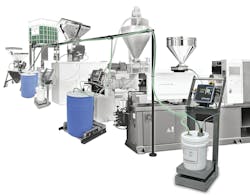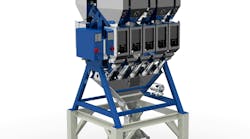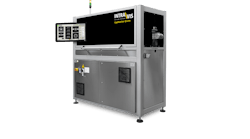“This is real-life,” said William Goldfarb, president of Una-Dyn, which supplied the injection molding plant’s auxiliary equipment. “We have a company that has 24 dry materials and sends them to over 50 machines that run through the night unattended. All through the night, materials are routed to the destinations. It flows from source to destination in an automated, validated routing. There is not one person in this plant.”
If something goes wrong with one of the injection molding cells, it shuts down, but the others continue running.
The plant has run lights-out overnight since 2016 without experiencing any extended downtime, Goldfarb said. Una-Dyn technology is in part responsible. It includes Easylink+ coupling stations paired with Winfactory 4.0 software from Una-Dyn’s Italian parent company, Piovan. Together, they can deliver the correct resin to the processing machine without human intervention.
“We convey a selection of materials from their source, like a silo, gaylord or surge bin, to their destination, like a machine,” Goldfarb said. “If a human had to go make that hose change to route that connection, they would need to be present. But we have automated solutions so that the material stream can flow automatically.”
Winfactory 4.0 software monitors a variety of equipment, including dryers, loaders and blenders, each of which has its own controller.
Una-Dyn isn’t alone in helping supply equipment to meet the needs of lights-out and lights-dim manufacturers. Lights-out manufacturing is impossible without enlisting advanced equipment for moving materials, maintaining temperatures and handling any number of other auxiliary tasks. Automated features, sophisticated software and internet connectivity make it possible.
Leister Technologies
Jason Sanders, a product specialist in Leister Technologies’ process heat division, said the company’s heaters and hot-air blowers are increasingly in demand in lights-dim and lights-out settings.
“Customers are always looking for ways to improve throughput while maintaining certain quality and safety standards,” he said.
Processors buy Leister heaters and hot-air blowers for deflashing plastic parts following injection molding.
The company offers heaters and hot-air blowers that can accept remote signals from a PLC to control heat and/or airflow depending on which model is being integrated into the process, Sanders said. They also provide alarm monitoring, which alerts users when the heater is too hot.
“In lights-out manufacturing, on the System series of heaters that we offer, we have the capability of accepting signals from, say, a programmable logic controller,” Sanders said. “As the machine is going through its motions to process material or other manufacturing applications, the system is monitoring the whole cell. The PLC sends out the signal to achieve the desired temperature and airflow setpoints, and if something goes wrong within the cell, the PLC sends out a signal to our equipment to stop calling for heat and put the cell into safe shut-down mode.”
Frigel
Frigel offers portable chillers, temperature- control units (TCUs) and central cooling systems capable of communicating via Ethernet or Wi-Fi with a user’s computer or manufacturing-execution system (MES), which can then send warnings and alerts to plant personnel. The communications capabilities — available on the Ecodry closed-loop cooling system and central chillers — are key to untended operations.
“We probably have about a half-dozen customers who are getting to the point where they are talking about lights-out,” said Al Fosco, Frigel North America’s marketing manager.
Models with advanced communications capabilities include the company’s portable, machine-side Microgel chiller/TCUs, which Frigel introduced about a year ago. The technology provides more information than previously was available for portable chillers, and Wi-Fi connectivity, in addition to wired Ethernet communications. Frigel soon will add the advanced control and Wi-Fi capabilities to its portable Turbogel TCUs.
In addition, last year the company began offering its MiND (machine interactive database) software and hardware package. MiND collects information from Frigel’s central and portable cooling equipment, compiles it and makes it available for remote monitoring. It also can send warnings and alerts to designated personnel.
MiND can facilitate lights-out operations by providing remote monitoring, adjusting equipment and letting personnel know if someone needs to intervene to bring a production cell back online.
In addition to monitoring Frigel’s equipment, MiND can also monitor some non-Frigel equipment, including flow meters, energy meters and other sensors. It also can store historical data and gather energy-consumption data.
Conair
Though they say very few plastics processors are running completely lights-out, Conair executives report a trend toward companies operating with more automation. Features of the company’s auxiliary equipment can help plants produce parts with fewer workers.
“Years back, you would have one operator for every one or two lines,” said Ernie Preiato, Conair’s VP of extrusion. “Today, we have customers who are running as many as 12 lines with just one operator.”
Many processors believe the best and most economical solution is to run with a few “light watchers”—people who can monitor the equipment and are available to respond if a problem develops and a machine shuts down.
Within the next month, Conair will roll out a new capability for its SmartServices cloud-based platform that supports that trend. SmartServices, which monitors and analyzes the performance of all auxiliary equipment, will soon allow users to access the setpoint and control screens of connected equipment. Compatible with both Conair and non-Conair equipment, the platform will provide users with the ability to answer alarms, troubleshoot and adjust machine settings remotely through a web-based dashboard.
From a single dashboard, SmartServices users can monitor process and equipment performance, track key performance indicators, follow production trends, and spot and address potential concerns before they cause downtime.
“It’s possible then that those ‘light watchers’ may not even need to be on the plant floor, or even in the same building, to keep equipment up and productive, whether the lights are on or not,” said Sam Rajkovich, VP of sales and marketing for Conair.
Riverdale Global
Paul Maguire, president and CEO of Riverdale Global, a liquid-color-management company, said his company also is “always looking to offer equipment that can run unattended.”
As an example, he said Riverdale Global’s RGInfinity auto-refill system refills liquid color drums inline, eliminating downtime for switching drums as well as lapses in color metering.
“This allows for long run times that can go through multiple shifts or a weekend unattended,” he said.
The company supplies liquid color in pump-equipped drums that remain sealed while color is metered to the processing machines. Its RGInfinity auto-refill system automatically refills one or more liquid color drums during the molding or extrusion process, eliminating downtime for switching drums and reducing the occurrence of transitional or off-specification product with little or no color, according to the company.
The system eliminates the need to replace those drums when empty by refilling them from a large central container. One central container can service a single machine or refill multiple machines running the same color.
In addition to reducing downtime and staff intervention, the RGInfinity system reduces scrap because the system eliminates off-color product typically produced during drum replacement.
“In addition, we offer GlobalTracker, which allows our metering equipment to be remotely monitored,” Maguire said.
Maguire Products
Making equipment that requires little operator intervention is a goal for Maguire Products, even if the company so far has seen little of the lights-out trend.
“I can tell you that from a global perspective, we have not seen many requests for ‘lights out manufacturing,’ ” Frank Kavanagh, VP of sales and marketing for Maguire Products, said. “That having been said, our equipment offers several features that are designed for minimal operator involvement throughout the production run.”
As an example, Kavanagh highlighted Maguire’s weigh-scale blenders, which are available in many models, with some capable of blending up to 12 compounds at rates of up to 8,000 pounds per hour.
The weigh-scale blenders can operate for long periods of time on their own thanks to the ability to store preprogrammed blending recipes and download recipes from remote computers.
“In the case of our dryers, they can be programmed to load and preheat for an early Monday morning startup,” Kavanagh said.
Moretto
Moretto addresses “lights-out production” needs by providing auxiliary equipment with a high degree of automation that can be remotely controlled by software.
It has helped build several plants that can operate with little or no human intervention. One recent example is its work with the Nemera Group, a medical-products manufacturer. With Moretto’s help, Nemera developed a new plant in France’s Normandy region that is capable of continuous production using injection molding machines with clamping forces ranging from 50 tons to 350 tons.
To facilitate lights-out production, Moretto provides interconnected, remotely controlled auxiliary equipment.
In Normandy, the company provided “intelligent” equipment, capable of optimizing automation, for each phase of the manufacturing process. The system also allows for the traceability of the lots. To avoid the risk of production stops, Moretto implemented redundancies throughout the process.
Central to Moretto’s systems is the company’s supervising and management system, called Mowis, which controls the entire automation chain, ranging from the storage of resin to its conveying and treatment, up to the injection molding machine. It controls all the equipment and systems in the plant with dedicated modules, allowing for total “4.0 traceability” of the process.
Mowis 3 is the latest version of Moretto’s supervision system, a tool for efficiently and safely overseeing “lights-out” production, according to Moretto.
Bruce Geiselman, senior staff reporter
Contact:
Conair Group,
Cranberry Township, Pa., 724-584-5500, www.conairgroup.com
Frigel North America Inc.,
East Dundee, Ill., 847-540-0160, www.frigel.com
Leister Technologies LLC,
Itasca, Ill., 855-534-7837, www.leister.com
Maguire Products Inc.,
Aston, Pa., 610-459-4300, www.maguire.com
Moretto USA LLC,
Jackson Center, Pa., 724-269-7600, www.moretto.com/en/
Riverdale Global LLC,
Aston, Pa., 610-358-2900, www.riverdaleglobal.com
Universal Dynamics Inc.,
Fredericksburg, Va., 703-490-7000, www.unadyn.com







